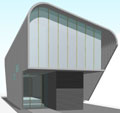(J)
Endo (Shuhei) (1960)
• Rooftecture M

| Based in Osaka since 1998, Shuhei Endo belongs to that generation of architects who, in the early 1990s, sought to go beyond the contradictions of "postmodernism". As the most blatant, not to say the most literal, example of "Folding Architecture" (Cf. Architectural Design, March 1993), Shuhei Endo's work aims, first and foremost, at rethinking the legacy of the "modern movement" in this day and age. Endo's architecture thus sees itself as "para-modern", and no longer breaking with, but rather linking up with a critical dialogue with the modernist Doxa. From this, Endo takes on the expressive mode, the effectiveness, and the phenomenological significance, but he rejects its analytical penchant for segregating formal features (post, beam, wall, roof, etc.). For Endo, the fold--a form which is at once complex and synthetic, smooth and knotted, and freed from the restrictions of Euclidian space--represents the preferred way of perceiving, in an ongoing way, the ever more numerous and contradictory elements of contemporary architecture. He has made corrugated steel sheet, which combines flexibility, water/airtightness and an auto-load bearing capacity, the basic material for this folding architecture. |
(J)
|
|
Shuhei Endo Architect Institute Endo (Shuhei) (1960) • Rooftecture M |
|
 |